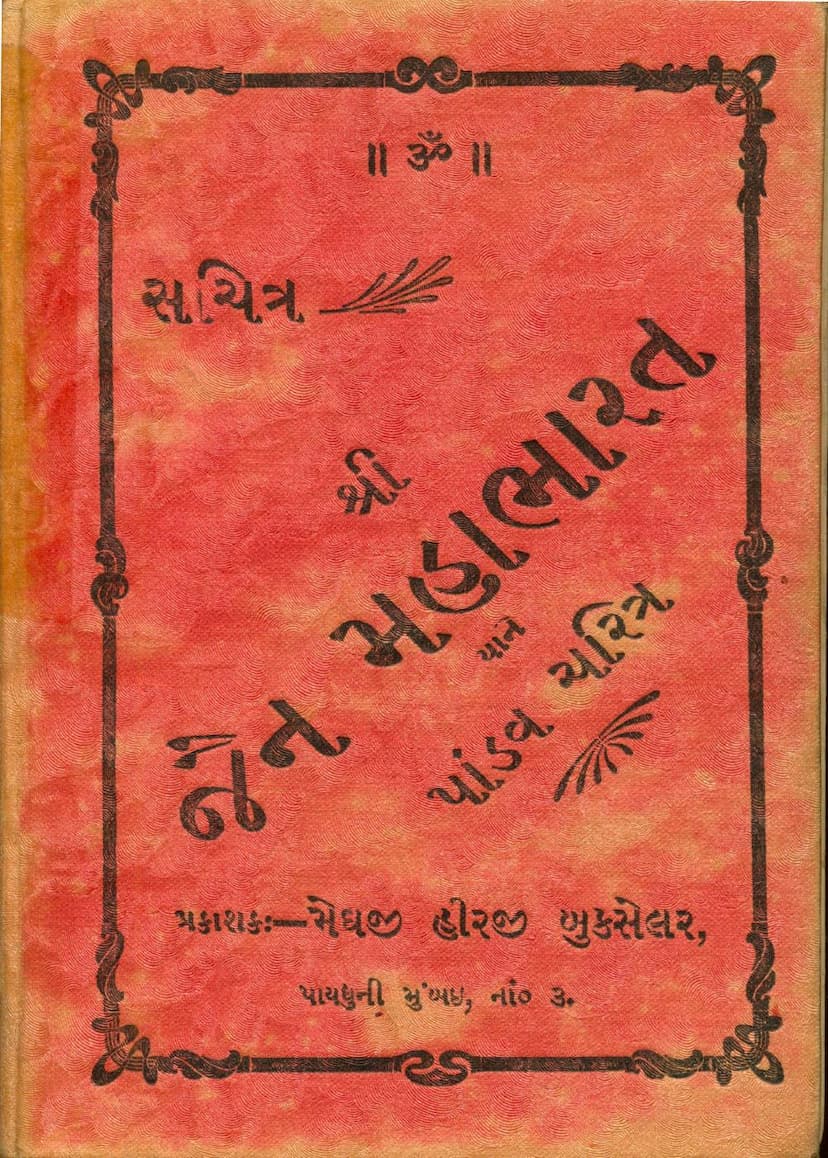Jain Mahabharat Yane Pandav Charitra
Added to library: September 2, 2025

Summary
Here's a comprehensive summary of the Jain text "Jain Mahabharat Yane Pandav Charitra" by Devprabhsuri, based on the provided pages:
Book Title: Jain Mahabharat Yane Pandav Charitra (Jain Mahabharata, or the Lives of the Pandavas) Author: Malladhari Shri Devprabhsuri Publisher: Meghji Hirji Bookseller, Paydhuni, Mumbai
Overall Theme and Purpose:
The "Jain Mahabharat" or "Pandav Charitra" by Devprabhsuri is a Jain adaptation of the epic Mahabharata, focusing on the lives and deeds of the Pandavas. The primary purpose of this text, as highlighted in the publisher's introduction, is to reintroduce and disseminate ancient Jain literature, which the publisher feels has seen a decline in enthusiasm. The book aims to satisfy and encourage the reading interest within the Jain community by presenting the stories of the Pandavas in a visually engaging format (sachitra - illustrated) and with a focus on the moral and ethical teachings that can be drawn from their lives.
Key Aspects and Content:
- Author and Publisher: The book is attributed to the esteemed Jain Acharya, Shri Devprabhsuri. It is published by Meghji Hirji Bookseller in Mumbai, indicating a focus on making religious and philosophical texts accessible to the public.
- Illustrations: The text explicitly states it is an "illustrated edition" (sachitra), highlighting its commitment to making the narratives more appealing and easier to understand, especially for readers who might be less familiar with Sanskrit and Prakrit texts. The publisher mentions the effort and expense involved in making the book illustrated, noting the difficulty in finding skilled artists after the passing of a previous collaborator, Shri T.J. Patel. They express gratitude to Shri Gordhanbhai Patel for his contribution to the illustrations.
- Moral and Ethical Teachings: The preface and chapter summaries emphasize the educational intent of the book. It seeks to guide readers to acquire good qualities such as Dharma, Niti (morality), Vinay (humility), Vivek (discernment), Chatura (cleverness), Utsah (enthusiasm), Shaurya (valor), Yuddha (warfare), Sadashya (truthfulness), Saundarya (beauty), Shakti (strength), Bhakti (devotion), Vairagya (detachment), and Madhurya (sweetness). Conversely, it aims to help readers avoid negative qualities like Adharma (unrighteousness), Aniti (immorality), Avinay (disrespect), Avivek (lack of discernment), and Murkhta (foolishness).
- Structure and Chapters: The book is divided into numerous chapters, each focusing on specific events or characters from the Mahabharata narrative, reinterpreted through a Jain lens. The table of contents (Vishayanukram) reveals a detailed breakdown of the stories, covering:
- The marriage customs and rejection of harmful practices.
- The character of King Shantanu, his hunting addiction, and the importance of self-control.
- The education and character of Ganga Sundari.
- Bhishma's devotion to his father and his vow.
- Satyavati's virtues.
- The conflict between father and son (Bhishma and Shantanu).
- The stories of Amba, Ambika, and Ambalika.
- The consequences of sensual indulgence (Vichitravirya).
- The miraculous ring incident and the stories of Vidhyadharas.
- The importance of family harmony and the perils of discord.
- The stories of Kansa and Jivayasha.
- The character of Krishna.
- The origin of the Pandavas and the seeds of enmity between Pandavas and Kauravas.
- The importance of learning and the ten aids to study (Guru, book, residence, help, study, health, intellect, humility, effort, love of scripture).
- The glory of Guru devotion, exemplified by Eklavya.
- The examination of princes, including Arjuna, Karna, and Duryodhana.
- The archery contest (Radha-vedh).
- The previous life of Draupadi and its lessons.
- Narada's teachings.
- The coronation of Yudhishthira.
- The conspiracies of Shakuni and Duryodhana.
- The story of Nala and its moral lessons.
- The incidents of gambling, exile, deception, hardships of exile, assurance of safety, and returning kindness for enmity.
- The influence of good and bad company (Satsang vs. Kusang), illustrated through Kansa's association with Vashudeva and Jarasandha's daughter Jivayasha.
- The beginning of Krishna's story and the beginning of enmity.
- The Kurukshetra War and its lessons on righteousness and unrighteousness.
- The story of Jarasandha and Krishna.
- Yudhishthira becoming the king of Hastinapur and the principles of his just rule.
- The character of Rajarshi Bhishma and his lifelong celibacy, truthfulness, and devotion.
- The stories of Nemi Prabhu and Rajimati, emphasizing chastity and renunciation.
- The incident of Draupadi's abduction and Krishna's involvement.
- The destruction of Dwarka and Krishna's death, illustrating the power of karma.
- The teachings of Muni Dharmaghosh and the Pandavas' final renunciation and salvation (Nirvana).
- Jain Interpretation: While the text follows the broad narrative arc of the Mahabharata, it is presented through a Jain philosophical and ethical lens. The emphasis is on virtues, ethical conduct, and spiritual progress, aligning with Jain principles. The summary of chapters indicates a focus on character development, consequences of actions (karma), and the path to liberation (moksha).
- Publisher's Commitment: The publisher, Meghji Hirji Bookseller, expresses a commitment to quality, mentioning the use of high-quality paper, beautiful printing, engaging illustrations, and captivating literature as their motto. They also note their efforts to make books affordable.
- Personal Note from Publisher: The publisher also shares a personal anecdote about the difficulties in creating the illustrated edition, particularly the search for a suitable artist after the demise of Shri T.J. Patel.
- Dedication: The book is dedicated to the publisher's mother, Jevlibai, acknowledging her profound influence and sacrifice.
Key Message for Readers:
The book aims to impart valuable life lessons derived from the characters and events of the Mahabharata, encouraging readers to cultivate virtues, understand the consequences of actions, and strive for spiritual well-being, all within the framework of Jain teachings. It seeks to be an accessible and inspiring resource for the Jain community.